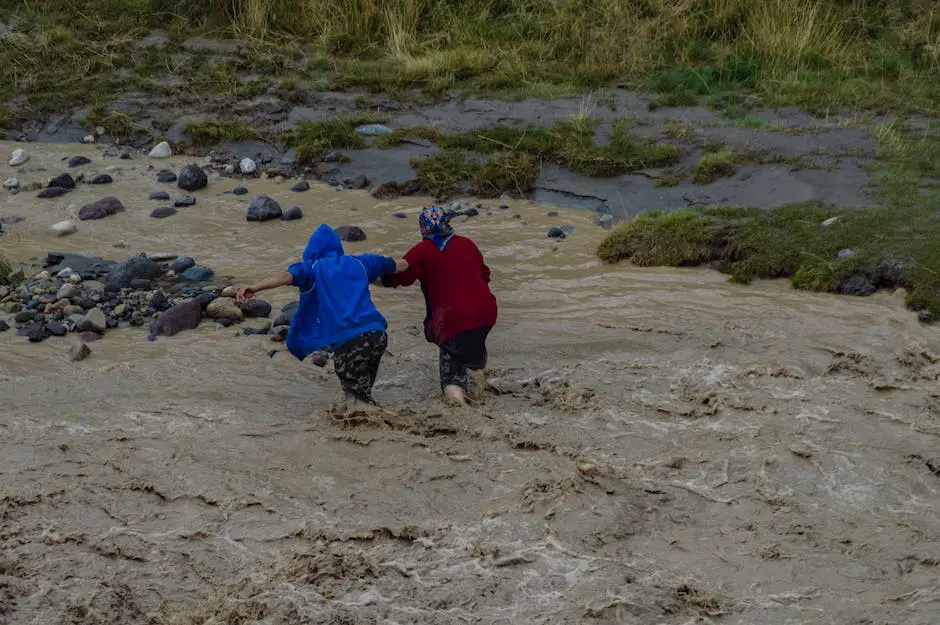The interpretation of biblical dreams, specifically dreams of floods, is rooted in histories, cultures, biblical narratives, and metaphysical symbolism. Insights drawn from historical and cultural backgrounds provide a crucial understanding of the significance of these dreams within the contexts of ancient Middle Eastern societies. Biblical narratives also play a key role in shaping our comprehension of these dreams, considering the multifaceted ways floods have been portrayed – as plot devices, purifying agents, punitive measures, or divine messages. Furthermore, understanding the symbolic and metaphorical significance of floods is pivotal in interpreting flood dreams as they carry a wealth of meaning, including destruction, purification, renewal, and divine intervention. This extensive overview brings to light the complexities and dimensions involved in biblical interpretation of flood dreams.
Historical and Cultural Context of Flood Imagery in the Bible
Navigating Dreams of Deluge: Historical and Cultural Contexts in Biblical Times
Dreams and visions, a pervasive theme throughout the biblical texts, provide a rich tapestry of cultural, social, and spiritual insights. Understanding them, particularly dreams involving flooding, requires delving into the lush depths of historical and cultural contexts of ancient periods. A scientist or historian reveling in the intricacies of dream interpretation is akin to a gardener laboring assiduously over an unruly patch of land – with each careful study, new shoots sprout, revealing a little more of the garden’s beauty and complexity.
Historically and culturally, flooding is a powerful and recurrent motif in biblical times, connoting both destruction and renewal. The Old Testament narrates the tale of Noah’s Ark, where a deluge was god’s tool for eradicating humanity’s wrongdoings, cleansing the world order. However, beyond mere destruction, these great floods also harbored the potential for new beginnings, making a way for reconstruction and innovation.
Within any civilization, water sustains life. It quenches thirst, nourishes crops, and signifies fertility. Peaceful waters are often associated with tranquillity and spiritual purity. In contrast, torrential waters or flood-like situations symbolize a tumultuous emotional state or societal upheavals. Thus, dreams of flooding hold substantial symbolic value and are considered potent messages, encouraging introspection.
Building on this, it is conceivable why flood dreams in biblical times held significance beyond what may initially meet the eye. Rather than purely catastrophic portents, they prompted both self-reflection and societal contemplation, probing the boundaries of normative behaviors and actions.
In societies where deity interpretation played a crucial role, dreams of floods were often perceived as divine messages or warnings. For instance, consider Joseph’s interpretation of Pharaoh’s dream in the book of Genesis; seven emaciated cows swallowed the seven healthy ones, which Joseph interpreted as an impending seven-year famine. Here, the metaphorical flood was not of water but of dire scarcity, yet the grounding principle of an imminent societal crisis remained consistent.
Looking through the lens of contemporary dream analysis, it is valuable to consider the cognitive-cultural approach, which frames our dreams as mirrored reflections of our experiences, norms, and beliefs that are culturally specific. Overlaying this theoretical understanding onto the interpretation of flood dreams in biblical times allows for a nuanced exploration of cultural contexts and communal paradigms that permeated societies of antiquity.
To conclude, comprehending the historical and cultural significance of flood dreams in biblical times requires insightful integration of historical data, spiritual symbolism, societal norms, and psychological theories. Such a comprehensive interpretative approach underscores the profound influences of historical and cultural contexts on dream narratives and their resonance within collective wisdom and knowledge.

Floods in the Biblical Narrative
Delving further into the subject, it’s crucial to consider the arguably pivotal role climate might have played in shaping the biblical narratives. Particularly, the mesopotamian societies were periodically ravaged by extreme flood events and it is likely that these real-life experiences influenced the narrative and metaphoric use of floods in biblical texts. This may have further shaped the biblical understanding of dreams about floods, framing it within a social context conditioned by the fear and reverence towards these unpredictable natural phenomena.
In analyzing dreams involving floods in biblical accounts, we notice that they invariably trigger crescendos of profound changes and are often harbingers of divine intervention. Notably, these dreams are not confined to merely drowning or survival scenarios, but extend to the dreamer’s engagement with and transcendence over the destructive waters, occupying a prominent position in the distinctive ‘dreamscape’ presented in biblical narratives.
Biblical flood narratives and dreams intersect most notably in the story of Joseph. His dream of seven lean cows swallowing seven fat cows, and seven scorched ears of grain devouring seven healthy ears, was interpreted as a prophecy of seven years of abundance followed by seven years of famine. Although not a flood, the looming threat of a destructive natural event is present, demonstrating the pivotal role such dreams played as spiritual and prophetic tools.
Despite these instances, the Bible scarcely mentions floods within the framework of dreams. Yet, when present, they serve as potent indicators of transformative periods. Decoding the biblical symbolism of dreams is a deeply complex process, as these narratives are more than mere records of ancient mentality. They depict the intersection of human psyche, socio-cultural realities, interspersed with divine realms often intensified by the use of powerful metaphors like floods. Woven within these intense narratives is an underlying meaning that assists in our understanding not only of ancient civilizations but also of contemporary cognitive processes, cultural paradigms, and spiritual symbolism that continue to play a dominant role in our societal framework.
The deeper understanding of biblical narratives, especially dreams and their intertwined relationship with natural elements like floods, not only unveils the spiritual and cultural fabric of the ancient societies but also transcends into the domain of existential truths and philosophical introspection. Such an in-depth exploration in this field, driven by the passion for unravelling the spiritual, historical, socio-cultural, and psychological layers of biblical narratives, brings new insights into the link between humanity, nature, and the divine, and rightly, adds another piece to the intriguing jigsaw puzzle of human existence.

Symbolism and Metaphorical Significance
The link between the climate and biblical narratives is evident when observing the distinct correlation between natural phenomena, and consequential events described within the Bible. Floods, both literal and symbolic, are utilized as powerful vehicles throughout numerous biblical accounts. They serve as an incarnation of divine intervention or as metaphoric lenses through which readers can glean deeper meanings. Not only are they treated as divine omens, but the climate itself, particularly floods, profoundly influenced the narrative arc of these biblical tales.
Delving into the symbolic significance of floods in dreams within biblical accounts offers further insight. Dreams often function as a divine conduit, a realm where God communicates vital messages to humanity. Decoding these symbolic floods found in dreams necessitates an understanding of a cryptic language steeped in symbolism and metaphor. Consequently, when a flood manifests in dreams, it may imply more than a deluge of water; it could potentially refer to an impending influx of change, challenge, or enlightenment.
An intriguing example of prophetic dreams is observed in the story of Joseph. Joseph’s dream elevates the flood into a prophetic tool, a portent of seven years of prosperity, followed by seven years of devastating famine. This transcends the dream’s narrative surface to become a harbinger of forthcoming events, thereby augmenting the symbolic potency of floods within the realm of the dreamscape. Joseph’s story illustrates the immeasurable value of dreams and their interpretation within the biblical context.
In contrast to their frequent appearance in biblical narratives, flood references within dreams are scarce in the Bible. Such rarity increases their perceived importance and fuels our intellectual curiosity to decode their meanings. The dearth of these references augments the significance of those that do appear. Their infrequency, ironically, draws a reader’s attention towards their metaphorical implications, thus drawing focus towards their interpretative richness.
Decoding the symbolism within biblical dreams is a complex process, largely due to the multifaceted nature of biblical texts. The layers of spiritual, historical, socio-cultural, and psychological dimensions within each narrative, create a nuanced matrix of meanings and interpretations. It necessitates more than understanding the symbology; one must delve into the intricacies of cultural and historical contexts, the accepted norms, and underlying psychology of biblical times.
In essence, biblical narratives and dreams are arenas of deeper meanings and implications waiting to be discovered. They offer a multi-layered read that intertwines spirituality, history, social norms, cultural contexts, and psychological theories. The exploration into their meanings enriches our understanding of the profound connectivity between humanity and the divine and propels us toward higher intellectual and spiritual comprehension.
Analyzing biblical texts, especially the symbolism of floods and their manifestation in dreams, highlights the intricate link between humanity, nature, and divinity. This exploration illuminates the boundaries of our symbolic imagination and propels our understanding of ancient wisdoms behind these enduring narratives. Our zeal to understand these dream narratives showcases our constant quest for knowledge and understanding, echoing the words of Proverbs, “In all thy getting, get understanding.” The understanding thus obtained, forms the backbone of deeper and more comprehensive interpretation of these biblical narratives, thereby accentuating their enduring relevance and indomitable spirit.

Contemporary Interpretation of Biblical Flood Dreams
Building upon the foundational understanding already established, it becomes evident that floods within biblical narratives and dreams serve as symbolic vehicles carrying nuanced meanings. These meanings reflect not only the climate during the time in question but also the interconnected dynamics of human relationships with nature and the Divine – a relationship bound intrinsically with the culture and ethos of the biblical era.
Traditionally, the biblical climate is depicted as harsh and punishing, serving as a backdrop to the lives of biblical figures. Frequent flooding and other natural predicaments of the time find their way into the narratives, carrying symbolic meanings and manifestations. These climatic conditions are considered to be divine interventions holding implications far beyond the immediate scenario. They often are vehicles for conveying divine messages, illustrating the power of divine agency intertwined with human existence.
Floods in dreams, though relatively sparse in the biblical account, have substantial significance. Taking the example of Joseph’s dream – it didn’t involve a flood but stood as a prophetic forecast of seven years of abundance followed by seven years of severe famine. This indicates the biblical perception of dreams as divine tools for prophetic declarations. While it doesn’t directly involve a flood, the catastrophic nature of a famine bears semblance to that of a flood – both implying trials and tribulations indicative of divine chastisement or admonition.
Decoding biblical symbolism, especially when it comes to dreams, is a complex task, owing to the layers of meaning encapsulated in these narratives. Biblical symbolism isn’t linear – it envelopes spiritual, historical, socio-cultural, and psychological threads into a densely intertwined tapestry of meanings, with each narrative bearing its unique repercussions.
The multi-layered nature of these narratives extends to dream interpretations too. On one hand, the flood could be interpreted as a warning sign, an impending doom indicating the need for repentance and change. On the other hand, it might symbolize a spiritual cleansing or purification, signifying the need for personal introspection and spiritual revival.
The analysis of such narratives and dreams requires not just an intimate knowledge of the biblical text but also an astute understanding of the sociocultural context within which these narratives unfurled. This knowledge allows the interpretation to transcend beyond a decontextualized literal approach to a more nuanced, contextual reading that reflects the dynamic and symbiotic relationship between humanity, nature, and the Divine as portrayed in the Bible.
The fascinating intersection of these domains forges a landscape ripe for research with bountiful opportunities for interpretations, particularly emphasizing the role of dreams in biblical contexts. In unraveling and decoding these narratives and dreams, one seeks to unlock doorways into deeper levels of understanding, a perpetual quest for wisdom that breathes life into the biblical text and its living relevance in contemporary religious studies.

Interpreting flood dreams within the Christian community continues to spark fascinating dialogues among theologians, psychologists, and dream interpreters, drawing heavily from the historical and cultural contexts, biblical narratives, and symbolism. These flood dreams, embodying themes of chaos, purification, renewal, or divine wrath, serve not only as spiritual guideposts but also as reminders of humanity’s inherently transient and evolving relationship with the Divine. The profound symbolism they carry and the insights they offer upend simplistic interpretations and call for introspection, comprehension, and respectful engagement with the mystery and unpredictability of divine communication. The underlying layers of meaning, context, and symbolism elevate biblical interpretation of flood dreams from mere prognostication to a profound journey toward understanding the human-divine connection.
